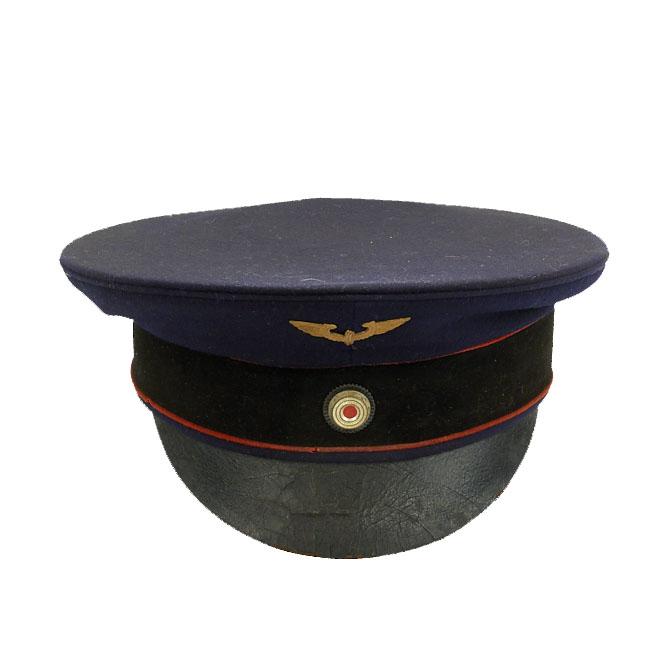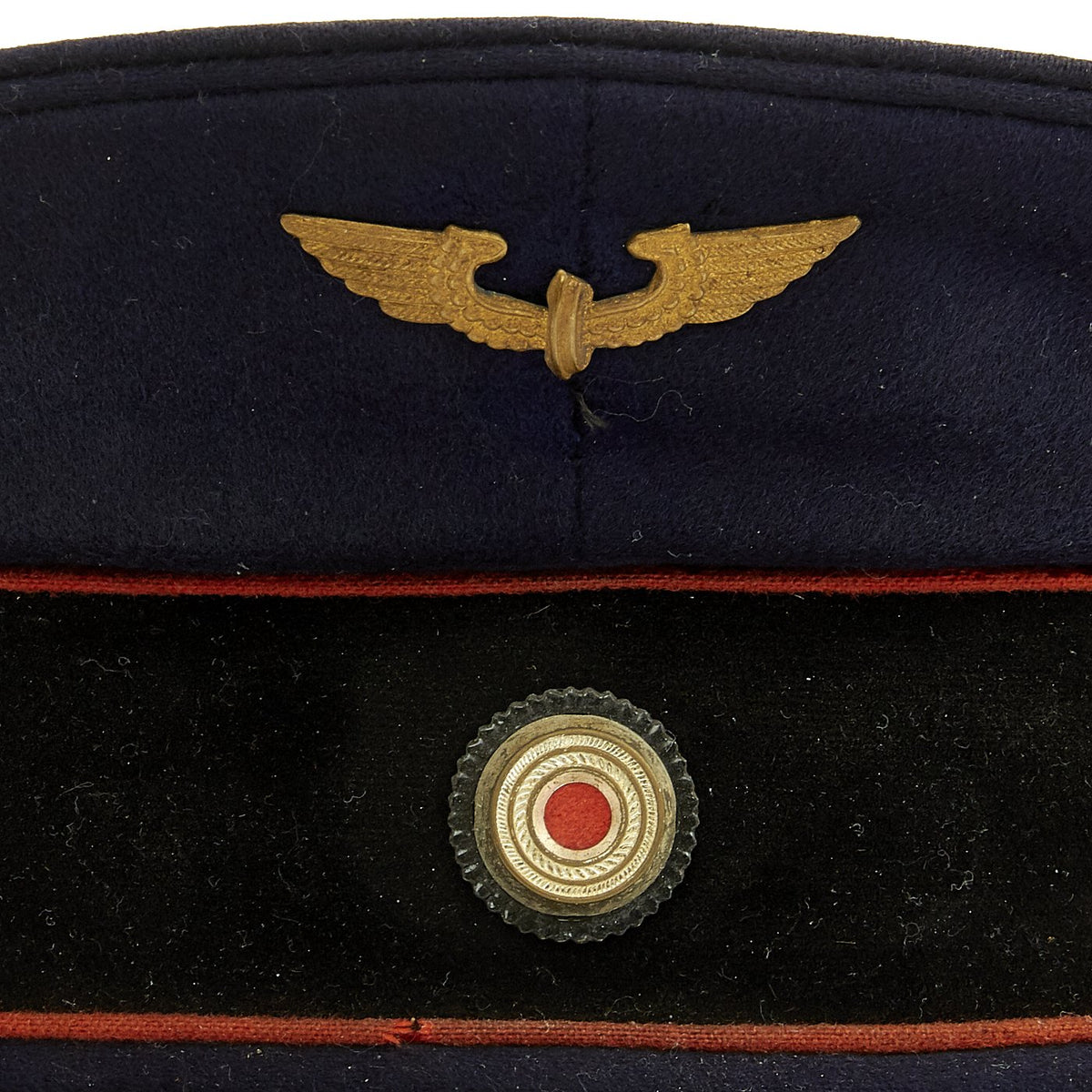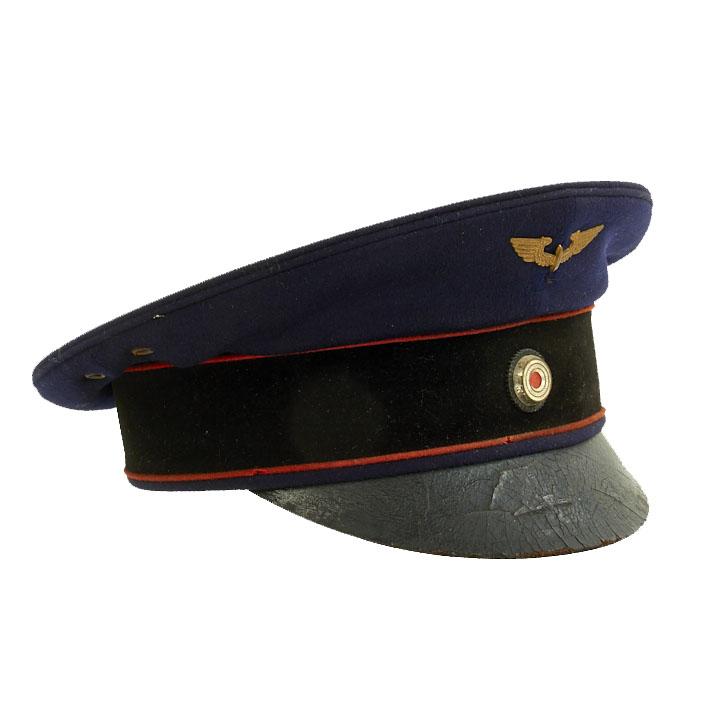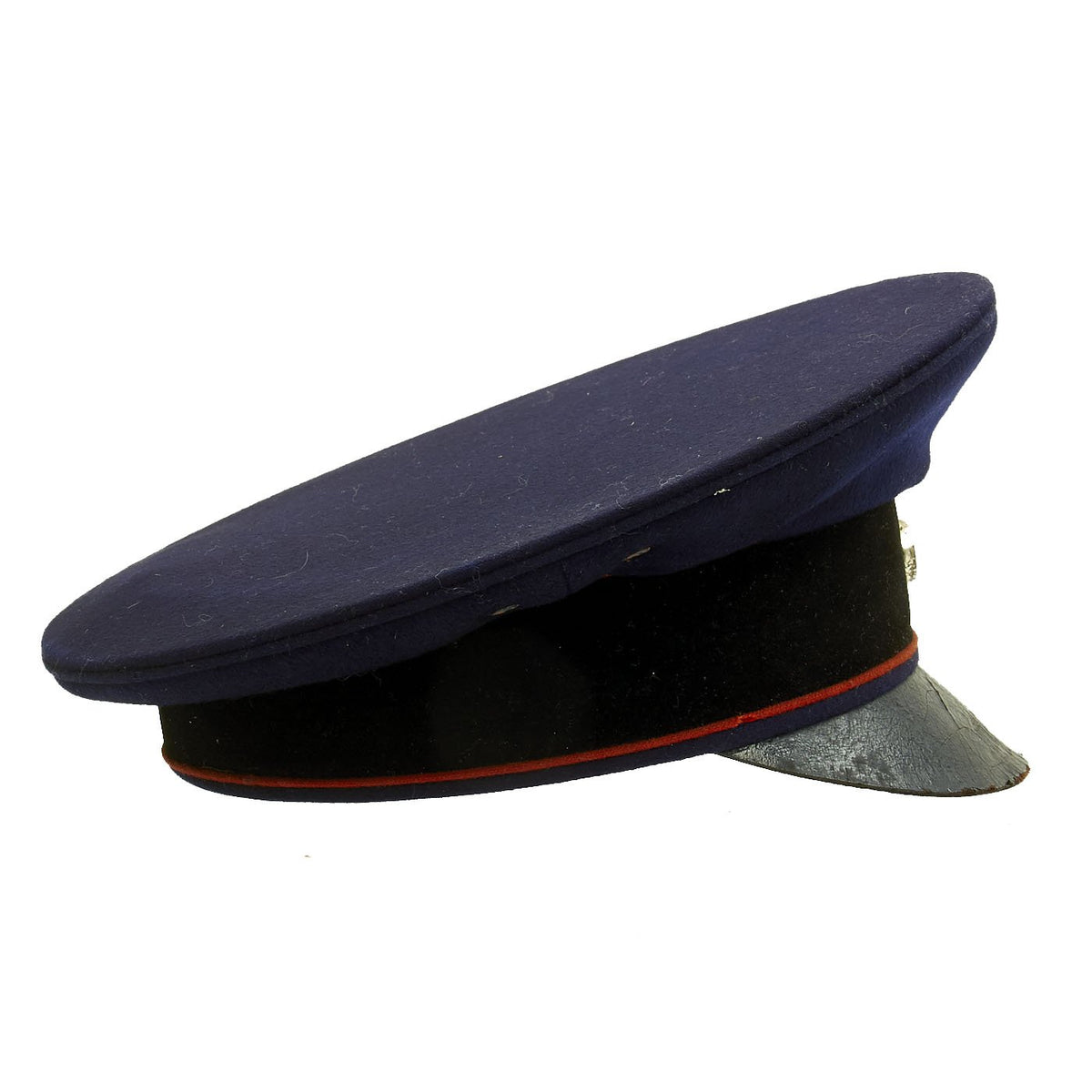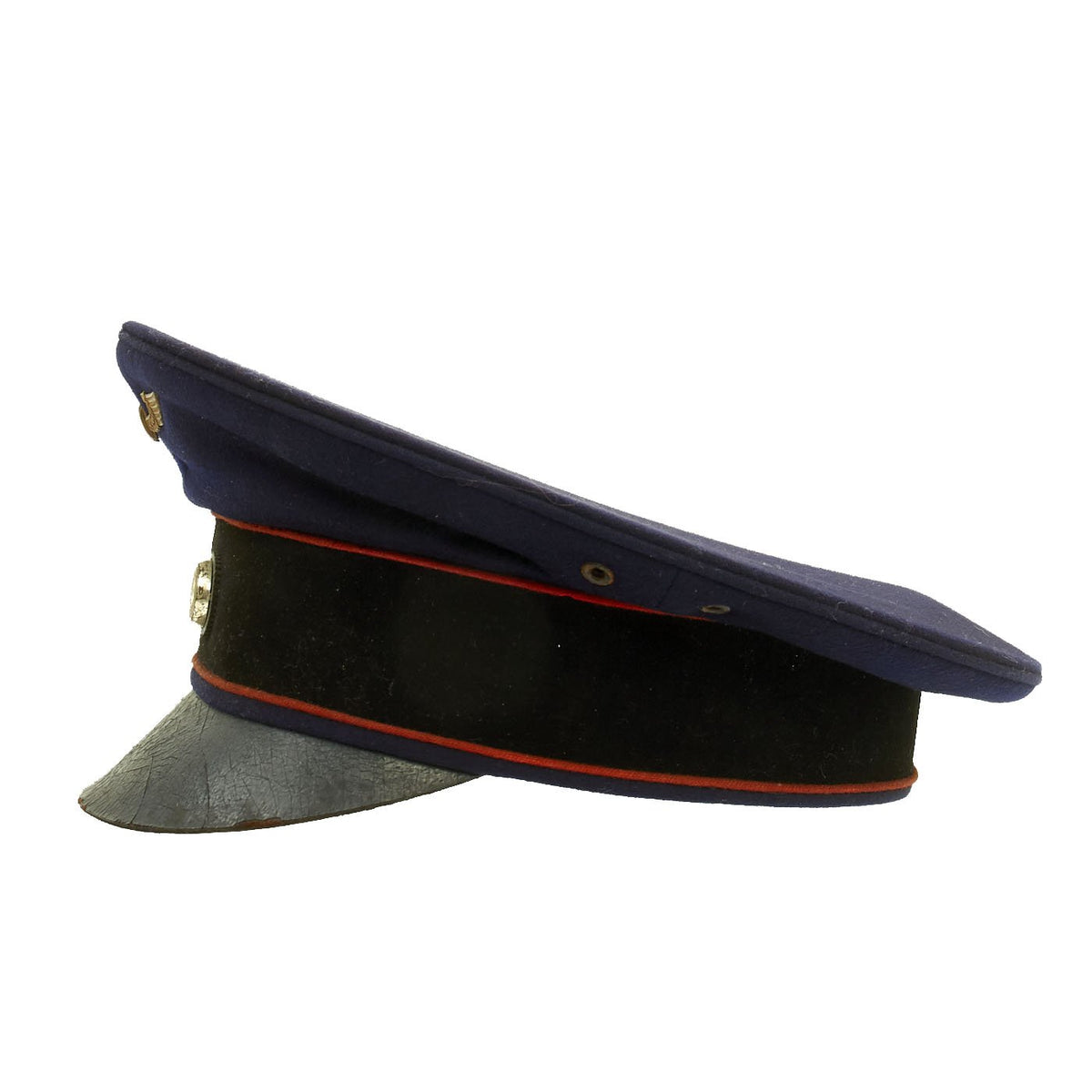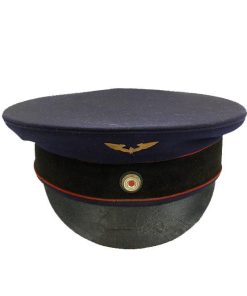Original German Pre-WWII Deutsche Reichsbahn-Gesellschaft Railway Visor Cap – circa 1930 Original Items
$ 350,00 $ 105,00
Original Item: Only One Available. This is a really attractive example of a Weimar Republic Period Pre-WWII German State Railroad Company (Deutsche Reichsbahn-Gesellschaft) visor cap. This cap is the standard enlisted style, with no chin strap and relatively spartan construction, and were used by various officials in the organization, including conductors.
The cap is of Dark blue wool construction is clean and shows moderate use. It features a nice velvet cap band, with a standard Tri-Color medal cockade with red felt center and a brass “Wings through a Train Wheel” insignia. This was the emblem of the Early Reichsbahn, before it was “NSDAPfied” and replaced with the standard NSDAP Reichsadler, while the DRB logo was moved lower on the cap.
The leather visor/peak of the cap is in good condition, though it does have some cracks in the leather finish. Interior is very clean with a faced makers mark on the crown. The sweatband is leather, with light wear and a nice finish. It is stamped with a size 56 marking. This pattern does not have any chin strap, and never had one installed.
A very nice example of a hard to find Pre-WWII cap, ready to display!
The visor cap (Schirmmütze) was an important part of the headgear worn by German uniformed military, civil, paramilitary and political organizations during the Third Reich. This was the standard cloth headgear worn as a part of the service uniform. Visor caps were worn outdoors as well as indoors, and were often required to be worn by all personnel on duty. Visor caps were made in versions specific to each organization and were often further differentiated through the use of insignia, colored piping, or style of chin cord, to indicate rank, role or branch. The insignia used on these caps ranged from simple stamped metal emblems, to elaborate hand embroidery. Visor caps were issued to enlisted soldiers and NCOs in the military and in some other organizations. Officers had to purchase their own hats, and lower ranks could choose to purchase caps that were of a higher quality than the rather basic, issue examples. The private purchase caps were generally made in very high quality, with fine materials. A wide variety of fabrics were used, from Trikot and doeskin, to heavy wool, or even lightweight white fabric for summer wear. In the military, issue of these caps was generally suspended shortly after the outbreak of the war, but they continued to be worn by some troops until the end of the war.
More on the Deutsche Reichsbahn-Gesellschaft (1924–1937)
Among the provisions of the 1924 Dawes Plan was a plan to utilize the state railway completely for the payment of war reparations. Following the plan’s publication, on 12 February 1924, the Reich government announced the creation of the Deutsche Reichsbahn as a state enterprise under the Reich Ministry of Transport (German: Reichsverkehrsministerium).
As this was not enough to satisfy the reparations creditors, on 30 August 1924 a law was enacted providing for the establishment of a state-owned Deutsche Reichsbahn-Gesellschaft (“German Imperial Railway Company”, DRG) as a public holding company to operate the national railways. The aim was to earn profits which, under the Dawes Plan, were to be used to contribute to Germany’s war reparations.
At the same time as the Reichsbahn law was enacted, the company was handed a bill of eleven billion Goldmarks to be paid to the Allied powers, while its original capital was valued at fifteen billion Goldmarks. These terms were later amended in the Young Plan. Nevertheless, the Great Depression and the regular payment of war reparations (about 660 million Reichsmarks annually) put a considerable strain on the Reichsbahn. Not until the Lausanne Conference of 1932 was the Reichsbahn released from its financial obligations. In total, about 3.87 billion Goldmarks was paid in reparations to the Allied powers.
During the DRG period the following milestones occurred:
- 1 October 1930: the DRG took over the Bremen Port Railway (Hafenbahn Bremen)
- 27 June 1933: the DRG’s sister company the Reichsautobahn was founded
- 1 March 1935: the railways of the Saar were incorporated
The beginning of the DRG was characterised by the acquisition of new rolling stock built to standard types, such as the standard steam locomotives (–Einheitsdampflokomotiven). The stock already in use had been inherited from the various state railways and comprised a great number of designs, many of them quite old. In fact, the DRG was unable to procure new stock in the numbers it wanted to both for financial reasons and due to delays in upgrading the lines to carry higher axle loads. The locomotive classes taken over from the old state railways, especially those from the Prussia, continued to dominate the scene until the end of the 1930s. They included, for example, the Prussian P 8 (BR 38.10-40), Prussian P 10 (BR 39), Prussian G 12 (BR 58.10) and the Prussian T 20 (BR 95). The Bavarian S 3/6 (BR 18.5) express locomotive even continued in production until 1930.
Not until the procurement programme for the wartime Kriegslokomotiven were new goods locomotives built in large numbers, but of course now for a very different purpose.
Taking lead from the German Labor Front, the Deutsche Reichsbahn took part in the conflict of intermarriage in Germany. In August 1933 Robert Ley, leader of Reich Labor, demanded that those administrators working for the German Labor Front be married only to German individuals. The Deutsche Reichsbahn took the lead in discriminating against intermarried workers, firing German employees married to Jews and forbidding intermarried Germans from working there in the future, starting in November 1933.
Fast Shipping with Professional Packaging
Thanks to our longstanding association with UPS FedEx DHL, and other major international carriers, we are able to provide a range of shipping options. Our warehouse staff is expertly trained and will wrap your products according to our exact and precise specifications. Prior to shipping, your goods will be thoroughly examined and securely secured. We ship to thousands clients each day across multiple countries. This shows how we're dedicated to be the largest retailer on the internet. Warehouses and distribution centres can be located throughout Europe as well as the USA.
Note: Orders with more than one item will be assigned a processing date depending on the item.
Before shipping before shipping, we'll conduct a thorough inspection of the items you have ordered. Today, the majority of orders will be delivered within 48 hours. The delivery time will be between 3-7 days.
Returns
The stock is dynamic and we cannot completely manage it because multiple stakeholders are involved, including our factory and warehouse. So the actual stock may alter at any time. It's possible that you may not receive your order once the order has been made.
Our policy is valid for a period of 30 days. If you don't receive the product within 30 days, we are not able to issue a refund or an exchange.
You can only return an item if it is unused and in the same state as the day you received it. You must have the item in its original packaging.
Related products
Uncategorized
Uncategorized
Uncategorized
Uncategorized
Uncategorized
Uncategorized
Uncategorized
Uncategorized
Armoured Fighting Vehicles of the World: AFVs of World War One (Hardcover Book) New Made Items
Uncategorized
Armored Burgonet Helmet & Polearm from Scottish Castle Leith Hall Circa 1700 Original Items
Uncategorized
Uncategorized
Uncategorized
Uncategorized
Uncategorized
Uncategorized
Uncategorized
Uncategorized
Uncategorized
